
- •Лекция 1. Вводно-коррективный курс План
- •1.Фонетический строй английского языка. Звуки. Буквосочетания.
- •Буквосочетания гласных
- •2. Английский алфавит
- •3. Чтение ударных и безударных гласных.
- •Четыре типа ударных слогов
- •2.Прочитайте слова и объясните, по каким правилам они читаются.
- •3. Выпишите слова в соответствии с правилами чтения типов слогов в четыре колонки.
- •4.Части речи Parts of speech
- •5.Местоимения Pronouns
- •6. Спряжение глагола to Be
- •7.Множественное число
- •7.Прочитайте вслух существительные, обращая внимание на произношение окончания множественного числа. Read the words aloudpaying attention to endings
- •8.Напишите данные существительные во множественном числе.
- •9.Догадайтесь о значении пар слов, если необходимо воспользуйтесь словарем. Выучите слова. Напишите их во множественном числе.
- •8.Притяжательный падеж
- •11.Заполните пробелы подходящими местоимениями
- •9. Использование артикля в английском языке
- •15.Вставьте артикль, где необходимо.
- •16.Вставьте артикль, где необходимо.
- •17.Вставьте артикль, где необходимо.
- •10. Глагол to be в Simple Past.
- •20.Переведите на английский язык, употребляя глагол to be в Present, Past..
- •Тема 2.
- •1.Название стран мира, национальностей и названий языков мира.
- •2. Английский язык - язык мирового общения.
- •3.Оборот there is / there are
- •5.Типы вопросительных предложений
- •Вопрос к подлежащему
- •6.Артикли с географическими названиями
- •Задания для самостоятельной работы
- •Литература
- •Тема 3. Великобритания План
- •1.Страдательный залог ( Passive Voice)
- •2.Географическое положение Великобритании.
- •3.Государственное устройство Великобритании
- •4. Монархия и Королева
- •Задания для самостоятельной работы
- •Литература
- •Тема 4.
- •1.Географическое положение и государственное устройство сша.
- •2. Символы сша.
- •II. Закончите предложения.
- •Тема 5.
- •Тема 6.
- •1.Географическое положение и государственное устройство Австралии
- •2.Страдательный залог времени Past Simple
- •3. Предлоги времени
- •4.Географическое положение и государственное устройство Новой Зеландии.
- •5.Словообразование прилагательных.
- •Тема 7 Корреспонденция: дружественное письмо План
- •1.План дружественного письма.
- •3.Словообразование глаголов
- •Литература
- •Тема 8. Устройство на работу План
- •Твоя профессия.
- •2. Приглашение новых работников.
- •3. Фразеологические единицы.
- •4. Количественные и порядковые числительные.
- •5. Глагол have, have got.
- •Литература
- •Дополнительная:
- •Тема 9. Типы компаний и должности Содержание темы:
- •Отделы компании.
- •Должности.
- •Блок-схема организации.
- •Типичный рабочий день.
- •Литература
- •Дополнительная:
- •Тема 10. Деловая корреспонденция
- •Литература
3.Государственное устройство Великобритании
Translate the words given from the text and learn them by heart. Then make up as many sentences as you can.
a parliamentary monarchy
the head of the state
the Queen
the King
the power
to act
advice
Parliament
Constitution
Legislation
to provide political rights
the House of Lords
the House of Commons
to be elected by
body
to win the election
The Prime Minister
To appoint
to compose the government
to be founded in
the Conservative party
the Labour party.
Habeas Corpus Act -Хабеас Корпус ( английский закон 1679г. о неприкосновенности личности )
Magna Charta -Великая хартия вольностей (1215г.)
Bill of Rights - "Билль о правах"
Act of Parliament- акт парламента, парламентский закон
Judicature Acts - свод правил, регулирующих работу Верховного суда Англии
12. Read the text about Parliamentary monarchy. Guess the meaning of underlined words.
Great Britain is a parliamentary monarchy. Officially the head of the state is the Queen (or the King). But the Queen doesn’t have the absolute power. She has to act only on the advice of Parliament the ministers and. There is no written constitution in Great Britain.
There are some main documents such as “Bill of rights”, “Magna Charta” Habeas Corpus Act, Act of Parliament (which defines the position of the House of Lords, the Judicature Act). All these documents express the main principles of British Legislation which doesn’t provide written guarantees of individual political rights.
Parliament in Great Britain was created in 1265. It is the eldest Parliament in the world. It consists of two Houses — the House of Lords and the House of Commons. The House of Lords consists of 1000 peers who are not elected by the people. The House of Commons is a nation-wide representative body which is elected by the people at a general election once in 5 years. After the general election the Queen appoints the head of the government — the Prime Minister. Usually the Prime Minister is the leader of the party that has won the election. The Prime Minister appoints the ministers to compose the government.
There are two main political parties in Great Britain: the Conservative party and the Labour party. The Conservative party came into being in the 19th century as a result of the evolution of the Tory party. The Labour party was founded in 1900. Since 1906 it has borne the name of the Labour Party. For the first time the Labour Party won the election in 1945.
Great Britain is one of the main industrial countries with developed industry. Machine-building, ship-building, metallurgy, electronics are the main industries in Great Brtitain.
4. Монархия и Королева
Read the texts about the British Queen for more information about Great Britain.
 'By
the sudden death of my dear father I am called upon to
assume the duties and responsibility of sovereignty. '
'By
the sudden death of my dear father I am called upon to
assume the duties and responsibility of sovereignty. '
These were the words of Her Majesty Queen Elizabeth II in her simple yet moving Accession Speech of 8 February 1952, just 36 hours after she had learnt that her father King George VI had died in his sleep. So, at the age of 25, Elizabeth Alexandra Mary, the first child of Prince Albert and Elizabeth, Duke and Duchess of York (later King George VI and Queen Elizabeth) became the forty-second sovereign of England since William the Conqueror, yet only its sixth Queen Regnant.
The Queen's Working Day
When The Queen is in residence at Buckingham Palace, every day is a working day, both for her and for the Duke of Edinburgh. They meet for a quick breakfast at half-past eight when they will discuss each other's daily programme but, unless they have joint engagements, they frequently do not see each other again until late evening. By 9.30 am Her Majesty is at her desk ready to start the day's routine
A digest of the day's newspapers will have been prepared for her by the Press Secretary with items of particular interest 1 marked or cut out. When Parliament is sitting, a report on the previous day's proceedings will have been delivered by the Vice-Chamberlain of the Household.
One
of Her Majesty's three Private 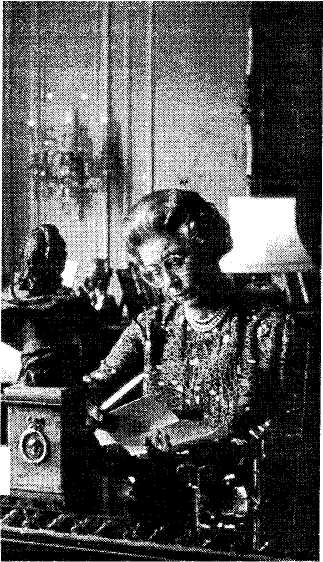 Secretaries
will then arrive with the morning's post. Letters from children are
usually
passed to one of the ladies-in-waiting for a
reply and certain official correspondence may
be sent on to the appropriate government
department for action. But there are
always plenty that require her own attention. Another frequent
duty of The Queen is the sending of around 2,000 centenary
telemessages each year to people who reach their hundredth
birthday.
Secretaries
will then arrive with the morning's post. Letters from children are
usually
passed to one of the ladies-in-waiting for a
reply and certain official correspondence may
be sent on to the appropriate government
department for action. But there are
always plenty that require her own attention. Another frequent
duty of The Queen is the sending of around 2,000 centenary
telemessages each year to people who reach their hundredth
birthday.
Throughout the working day a number of visitors will call ranging from incoming or outgoing diplomats to Her Majesty's dressmakers, who may arrive to discuss the wardrobe for a forthcoming overseas tour.
Once a month a meeting of the Privy Council is held in order that the Royal Assent may be given to various items of government legislation. At the end of the morning Her Majesty usually lunches alone and then in the afternoon she will often have an engagement in the London area. On her return she may well hold important domestic discussions with the Master of the Household, for Her Majesty is not only the Sovereign but also mistress of the house - the largest house in the country. Towards the end of the day there is always another pile of official papers, government documents and reports to be read, initialled or acted upon.
ROYAL TRAVEL
The Queen has occupied the throne for over 40 years and has travelled more widely than any other British monarch. Every year she undertakes at least two major overseas State Visits, accompanied by the Duke of Edinburgh, with shorter official tours in between, such as visiting Normandy in 1994 for the fiftieth anniversary of the D-Day landings.
H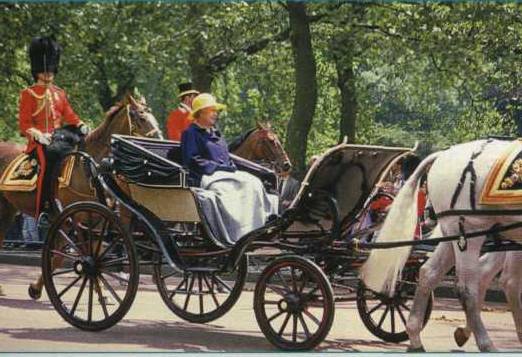
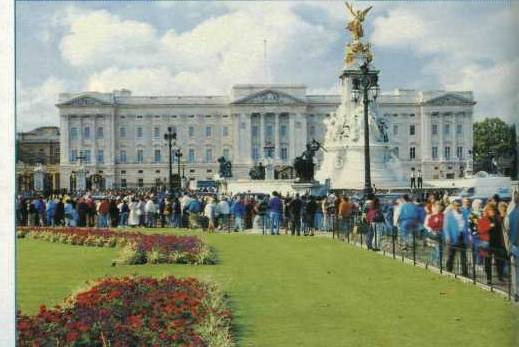 er
Majesty (HM) has made great use of the Royal Yacht Britannia,
which
was launched by her in 1953, the year of the
coronation, and which has since travelled over 1,000,000 miles.
Britannia
has
served as a royal residence and a setting for official entertainment
by The Queen and members of the Royal Family, and has also been used
for the promotion of British
commercial interests overseas.
er
Majesty (HM) has made great use of the Royal Yacht Britannia,
which
was launched by her in 1953, the year of the
coronation, and which has since travelled over 1,000,000 miles.
Britannia
has
served as a royal residence and a setting for official entertainment
by The Queen and members of the Royal Family, and has also been used
for the promotion of British
commercial interests overseas.
The Royal Yacht has the distinction of being the last ship in the Royal Navy whose sailors slept in hammocks. In June 1994 it was announced that HM Yacht Britannia would be de-commissioned in 1997 in view of her age and the expense of maintaining her. She is the second oldest ship in the Royal Navy, only Nelson's flagship, HMS Victory, being older.The role of The Queen's Flight is to provide air transport for The Queen, members of the Royal Family and certain senior government ministers. It consists of three BAe 146 medium-range jet aircraft and two Wessex helicopters.
Whenever the Queen or any other member of the Royal Family travels on land, either by road or rail, the arrangements are made by the Crown Equerry, whose office is located in the Royal Mews. The Crown Equerry is responsible for the 30 horses used in State processions and which are kept in the royal stables, as well as for the magnificent collection of State coaches and carriages. He also looks after the five Rolls-Royce limousines kept in the Mews. Whenever Her Majesty is travelling in one of her official cars a solid-silver mascot depicting St George and the Dragon is fixed to the limousine bonnet.
A favourite method of travel for all the Royal Family is the Royal Train which is owned and operated by British Rail. Prince Charles designed part of the interior of his quarters and the Duke of Edinburgh frequently uses the train for business meetings for one of his many organizations. All royal journeys are charged to the Privy Purse (The Queen's treasury) who reimburse British Rail for every mile travelled.
19. Write out unknown words out of the text. Use them to speak about royal travelling.
20. Read and translate the text about the queen’s charges to entertain her quests.
ROYALTY ENTERTAINS
T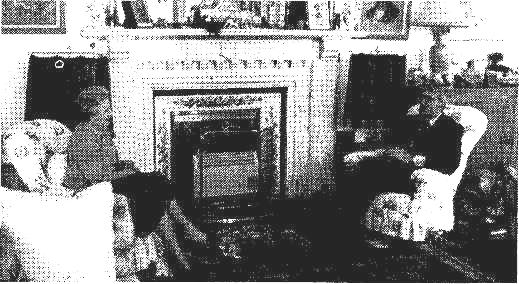 he
Queen is the country's official hostess entertaining, on
behalf of her people, guests from all over the world. She has
been described as the most generous hostess in the world with
no other Head of State entertaining on quite the same scale.
Her Majesty welcomes visiting monarchs, princes, sheiks
and presidents to her palaces, castles, the Royal Yacht and even to
her private homes at Balmoral and Sandringham, where
they are treated to a unique hospitality.
he
Queen is the country's official hostess entertaining, on
behalf of her people, guests from all over the world. She has
been described as the most generous hostess in the world with
no other Head of State entertaining on quite the same scale.
Her Majesty welcomes visiting monarchs, princes, sheiks
and presidents to her palaces, castles, the Royal Yacht and even to
her private homes at Balmoral and Sandringham, where
they are treated to a unique hospitality.
In addition to the State Banquets required by protocol to be held in honour of visiting Heads of State, The Queen will host numerous official dinners and lunches throughout the year. At Windsor Castle close friends are invited to a continuous house party throughout Royal Ascot week each June.
Windsor is also the scene of The Queen's large Christmas party where the family gathering has now expanded to include more than 40 people. New Year is spent at Sandringham where the Duke of Edinburgh hosts a series of shooting parties, and in August the royal couple move to Scotland where, once again, a large number of guests arrive at Balmoral. A tradition has grown whereby the Prime Minister and his wife are invited for a weekend, which usually includes several hours discussing affairs of State.
When the Court moves to the Palace of Holyrood house in Edinburgh for one week in July, another round of parties then begins with an official dinner every evening and a Garden Party for 6,000 guests held in one of the most attractive settings in Britain.
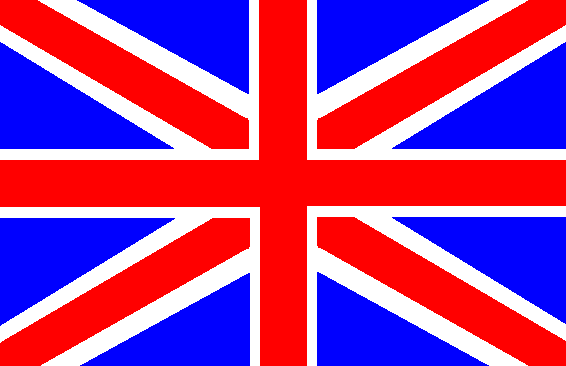 Union Jack
Union Jack
T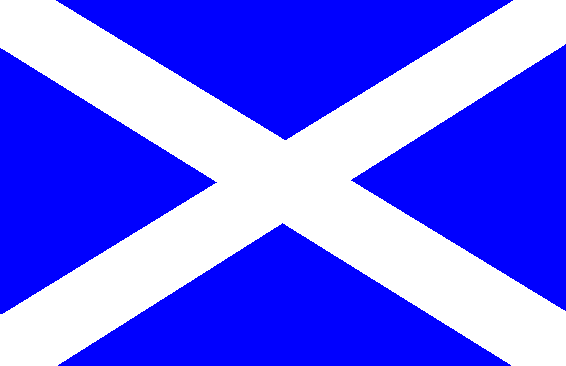 his
is popular name given to the flag of Great Britain. Actually it is
called the Union Flag and it is a mixture of several flags.
his
is popular name given to the flag of Great Britain. Actually it is
called the Union Flag and it is a mixture of several flags.
It all began in 1606 when Scotland was joined to England and Wales. The Scottish flag, St Andrew’s Cross, blue with a white cross from corner to corner, was joined to the English
F lag,
St George’s Cross, white with a red cross. The flag of St George
can still be seen on churches in England.
lag,
St George’s Cross, white with a red cross. The flag of St George
can still be seen on churches in England.
Later, in 1801, when Ireland was joined to the Union, as it was called the Irish Flag of St Patrick’s Cross added, white with a red cross from corner to corner.
In this way
the English people got the Union Flag whish is red, white and blue.
King James the Third (1566-1622) ordered that the Union Flag should
be flown on the main m ast
of all British ships, except on ships of war. Here the flag was flown
at the front of the ships, on whet was called the Jack Star and so we
get the mane of Union Jack. A “jack”, by the way, is an old word
for the sailor. The Union Jack is also on the flags of Australia and
New Zealand.
ast
of all British ships, except on ships of war. Here the flag was flown
at the front of the ships, on whet was called the Jack Star and so we
get the mane of Union Jack. A “jack”, by the way, is an old word
for the sailor. The Union Jack is also on the flags of Australia and
New Zealand.
